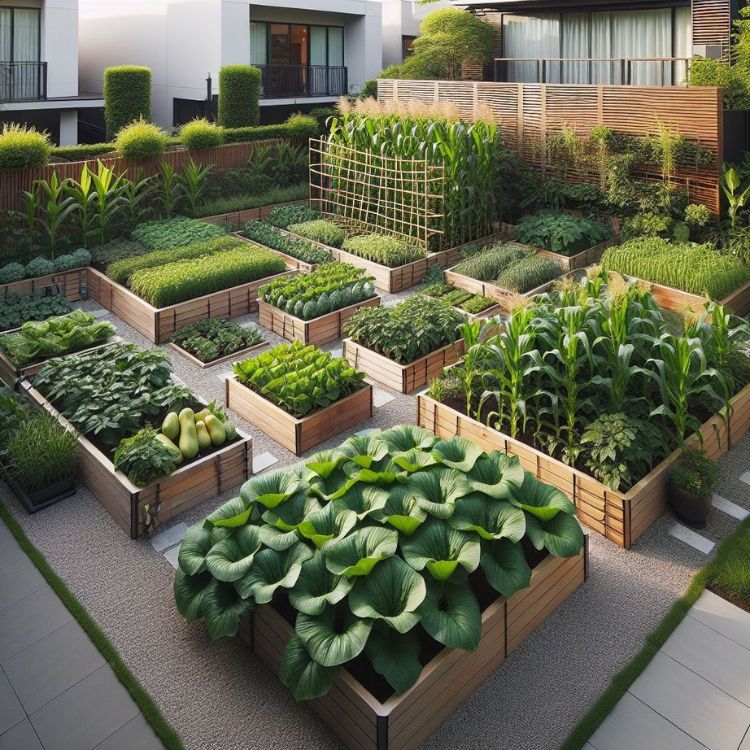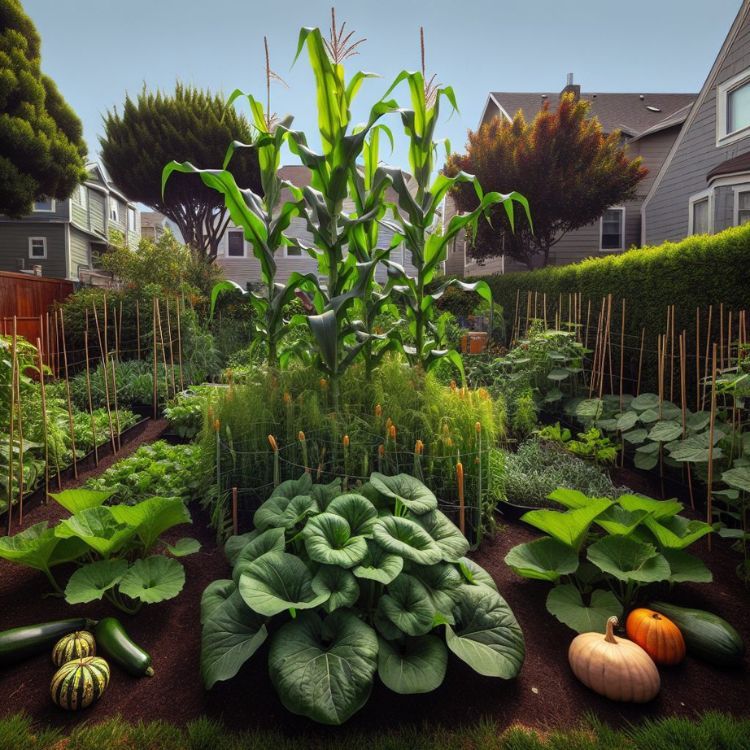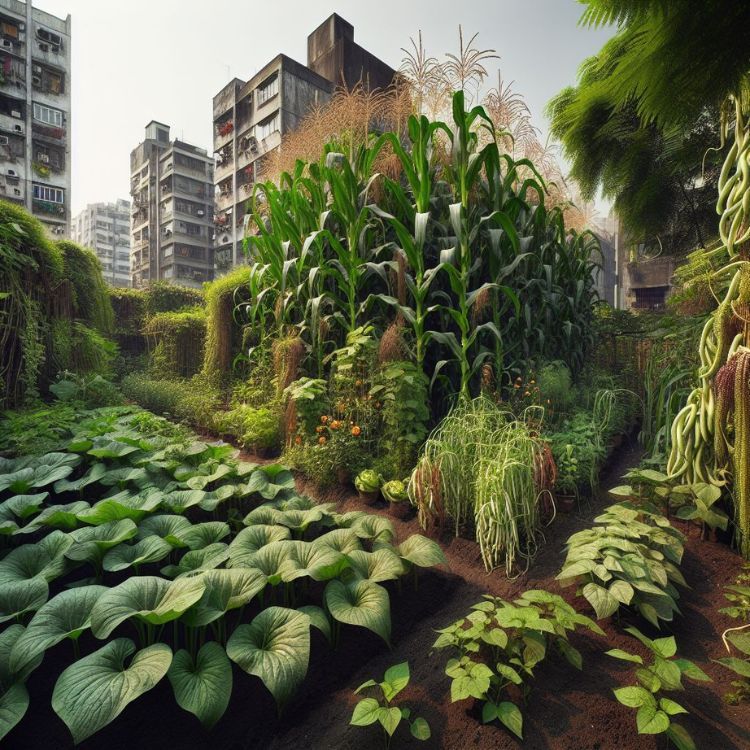
Key Takeaways
Embrace the time-honored Native American Three Sisters planting method to maximize yield in your urban garden.
Understand how maize, beans, and squash can symbiotically thrive even in limited city spaces.
Discover the specific growth needs of maize and how to choose the best varieties for urban environments.
Learn how to use beans as natural trellises for maize, creating a dynamic duo that saves space and boosts productivity.
Implement the use of squash as a ground cover to protect your urban crops and enrich your garden’s ecosystem.
Discover the Magic of Maize: The Cornerstone of Urban Gardens
When you think of urban gardening, you might picture small plots with limited options. But what if I told you that you could grow a bountiful, interconnected garden using techniques that have stood the test of time? Enter the Three Sisters planting method, a Native American agricultural tradition that pairs maize, beans, and squash in a harmonious trio that supports and benefits each other. This method is perfect for urban gardens where space is at a premium but the desire for abundance is vast.
Understanding Maize and Its Role in Companion Planting
Maize, or corn, isn’t just a staple crop; it’s a towering beacon in the garden that serves a dual purpose. Not only does it provide sustenance, but it also acts as a sturdy trellis for beans to climb. This relationship is a key component of the Three Sisters method. When you plant maize, you’re setting the stage for a vertical garden that uses space efficiently and creates a micro-ecosystem where each plant supports the others.
Growth Requirements for Maize in Urban Spaces
Even in the heart of the city, maize can flourish if you give it what it needs. First, choose dwarf or short-statured varieties that are better suited for smaller spaces and less likely to shade out other plants. Then, ensure your maize gets full sun – at least six hours a day – and plant it in fertile, well-draining soil. Remember, maize loves company, so plant it in blocks rather than rows to encourage pollination and, ultimately, a better harvest.
Climbing to New Heights: Beans as Natural Trellises
Beans are the perfect partner for maize in an urban garden. They’re climbers by nature, and when you plant pole or runner beans next to maize, they’ll use the sturdy stalks to reach for the sky. This not only saves space but also creates a striking visual in your garden. Beans also have a secret superpower: they fix nitrogen in the soil, which is a boon for maize that craves this essential nutrient.
Example: In my own urban garden, I planted a variety of pole beans next to my maize. Not only did they climb up and create a living green curtain, but they also improved the soil quality for next year’s crop.
Choosing the Right Bean Varieties for Your Urban Garden
When selecting beans for your Three Sisters garden, opt for varieties that are known climbers. Pole beans and runner beans are ideal because they have the ability to grow upwards naturally. Look for varieties that are disease-resistant and suited to your climate. If you’re short on space, choose beans that can be harvested multiple times throughout the season to maximize your yield.
Tips for Ensuring a Strong Corn-and-Bean Partnership
Plant your maize first and give it a head start – two weeks is usually enough time for it to establish before you add beans.
When it’s time to plant your beans, place them about 6 inches from the base of the maize to avoid crowding the roots.
Water consistently, especially as the beans start to climb, to ensure both plants stay hydrated and healthy.
Ground Cover Champions: The Role of Squash
The third member of the Three Sisters is squash, and it’s more than just a tasty vegetable. It plays a crucial role in the health and productivity of your urban garden. As the squash plants grow, their broad leaves shade the soil, keeping it cool and moist. This natural mulch reduces water evaporation, suppresses weeds, and creates a habitat for beneficial insects.
Types of Squash Suited for Smaller Gardens
When you’re choosing squash for your urban garden, look for compact or bush varieties that won’t take over your limited space. Summer squash like zucchini or pattypan are great choices because they can be harvested continuously throughout the season. Winter squash with a vining habit can work too if you train them to grow vertically or along the edges of your garden where they have room to roam.
Using Squash to Protect and Nourish Your Urban Garden
But squash does more than just provide shade. It also helps prevent soil compaction with its sprawling growth, ensuring that air and water can move freely in the soil. This is especially important in urban gardens where soil can often become compacted from foot traffic or construction. Moreover, the prickly hairs on some squash plants can deter pests, providing a natural defense system for your garden.
Space-Saving Tips for Urban Gardening Success
Space is often the biggest constraint in an urban garden, but with a bit of creativity, you can grow more than you ever imagined. The key is to think vertically. Trellises, wall planters, and hanging baskets all offer ways to grow upwards instead of outwards. And remember, the Three Sisters method is inherently space-efficient, with each sister supporting the growth of the others in a compact, integrated design.
Another tip is to use reflective surfaces like white walls or mirrors to bounce additional light onto your plants, which is especially useful in shaded urban areas. This can help increase the photosynthesis process, vital for plant growth. And don’t forget about succession planting – staggering the planting times of your crops can give you a continuous harvest in the same amount of space.
Maximizing Vertical Space for Urban Crop Growth
To really make the most of your vertical space, consider installing a green wall. This can be as simple as attaching planters to a wall or as complex as a hydroponic system. Not only does it look stunning, but it also allows you to grow a multitude of plants in a very small footprint. For your Three Sisters garden, you can use a sturdy trellis for the beans to climb the maize, while squash spreads at the base.
Don’t overlook the power of containers, either. Many urban gardeners have found success growing maize in large pots, with beans winding up the stalks. Just be sure to choose containers that are deep enough to accommodate the roots of your plants and have adequate drainage.
Container Gardening: The Three Sisters in Pots and Planters
Choose deep pots for maize to ensure room for root growth.
Use trellises in the pots for beans to climb, saving space and creating a visually appealing setup.
Select squash varieties that are suited to container life, such as compact bush types.
Container gardening can be incredibly rewarding and is a perfect fit for the Three Sisters method. It allows for greater control over soil quality and moisture levels. Plus, you can move the containers to make the most of sunlight throughout the day, which is particularly useful in the changing light conditions of the city.
When setting up your containers, consider grouping the Three Sisters together in one large container or in separate pots that are positioned close to each other to maintain the symbiotic relationship. And always remember to water container plants more frequently, as they dry out faster than ground soil.
Containers also make it easier to manage pests and diseases. By isolating plants, you can quickly identify and address any issues before they spread to the rest of your garden. This is crucial in an urban setting where space is limited and plants are closer together.
Maintaining Harmony Among the Three Sisters

For the Three Sisters to thrive, they need to be in harmony, and that starts with proper planning. Plant your maize when the danger of frost has passed and the soil has warmed. Two weeks later, sow the beans around the base. Finally, once the maize is about a foot tall, plant your squash seeds.
But the harmony doesn’t end with planting. You’ll need to monitor the growth of each sister to ensure they are supporting rather than competing with each other. If one plant is overshadowing the others, don’t be afraid to trim it back. Harmony also means balance in the nutrients each plant receives, so consider using a balanced, organic fertilizer to keep the soil fertile without favoring one plant over the others.
The Secrets of Soil Fertility in Urban Environments
Soil is the soul of your garden, and in an urban environment, it needs a little extra love. Start with a soil test to understand what you’re working with. Then, enrich your soil with compost, which provides a slow-release source of nutrients and improves soil structure. You can even make your own compost from kitchen scraps, a double win for city dwellers by reducing waste and enhancing their garden.
Creating an Urban Garden Ecosystem: Insects and Pollination
Creating a balanced ecosystem is vital for an urban garden. Attract beneficial insects like bees and ladybugs by planting flowers among your crops. These insects not only pollinate your plants but also keep pest populations in check. Consider plants like marigolds, which can deter nematodes, and herbs like dill, which attract beneficial wasps that prey on garden pests.
Remember, a diverse garden is a healthy garden. Diversity in plant life not only makes your garden more resilient, it also creates a more inviting space for pollinators. And when it comes to pollination, especially for crops like maize that rely on wind, positioning is everything. Make sure your maize is planted in blocks rather than single rows to maximize pollination chances.
Nature’s Bounty: Harvesting and Storing Your Urban Garden Produce
After nurturing your garden, the moment of truth arrives: harvest time. The key to a successful harvest is timing. Pick beans when they’re young and tender, squash when the rind can be pierced with a thumbnail, and maize when the silks are brown and the kernels are milky when pressed. Each sister has her own sign that she’s ready to be harvested, so stay vigilant and enjoy the fruits of your labor.
Knowing When It’s Time to Harvest Each of the Three Sisters
For maize, the ears should feel full and the kernels plump. With beans, you want to harvest before they become too large and tough. Squash is a bit more forgiving; summer varieties can be picked when small, but winter squash should be allowed to mature on the vine until the skin hardens. By paying attention to these signs, you’ll ensure the best flavor and texture for your produce.
Another tip is to harvest in the morning when the plants are full of moisture. This will give you the crispest beans, the juiciest maize, and the most succulent squash. And don’t forget to check your plants every day as harvest time approaches; sometimes the difference between perfect and past-prime is only a matter of days.
Compatible Plants to Grow Alongside the Three Sisters
In addition to the Three Sisters, there are other plants you can introduce to your urban garden that will complement and even enhance this trio. Consider adding flowers like nasturtiums, which are not only edible but also attract pollinators and beneficial insects. Herbs such as basil and cilantro can also be great companions, offering their fragrant leaves to your culinary creations and further attracting beneficial insects. Here are a few plants to consider:
Nasturtiums: These bright flowers draw in pollinators and can help deter certain pests.
Basil: Aromatic and beneficial, basil can help repel insects like mosquitoes and thrips.
Marigolds: Known for their pest-repelling properties, they also add a splash of color to your garden.
Borage: This herb can attract bees and other pollinators, and it’s said to improve the flavor and growth of strawberries.
By incorporating these plants, you not only add beauty and variety to your urban garden but also contribute to a healthier and more balanced ecosystem. And most importantly, these plants can coexist without competing for resources, making them perfect neighbors for the Three Sisters.
Adapting Indigenous Techniques to Modern Urban Gardens

The beauty of the Three Sisters planting method lies in its adaptability. While it’s rooted in Native American agriculture, it can be seamlessly integrated into modern urban gardening practices. The key is to respect the principles of companion planting and recognize the interconnectedness of the plants. By doing so, you’ll create a garden that’s not only productive but also a vibrant ecosystem in its own right.
As you adapt these techniques, remember to observe and learn from your garden. Take note of what works well and what doesn’t, and don’t be afraid to make adjustments. Gardening, after all, is an ongoing experiment, and each season brings new opportunities to refine your approach.
Frequently Asked Questions
Can the Three Sisters planting technique work in any climate?
While the Three Sisters method is versatile, it does best in climates that offer enough warmth and sunlight for maize to mature. That said, with the right choice of plant varieties and some modifications, such as using shorter season crops or starting seeds indoors, you can make it work in cooler climates as well.
It’s important to choose varieties that are suited to your specific climate. For example, if you live in a cooler region, look for cold-tolerant maize and beans, and consider using a cold frame or greenhouse to extend the growing season for squash.
How do you manage pests in an urban Three Sisters garden?
Pest management in an urban Three Sisters garden relies heavily on prevention and natural remedies. Planting a diversity of crops, as mentioned earlier, can help deter pests. Additionally, practicing crop rotation and using organic mulches can prevent many common garden pests. If pests do appear, try using natural deterrents like neem oil or insecticidal soap before resorting to more aggressive treatments.
Remember, healthy plants are less susceptible to pests, so keep your garden well-watered and fertilized with organic matter. And when you do spot pests, act quickly to prevent them from getting out of hand.
What are the best seasons to plant the Three Sisters in an urban setting?
The best time to plant the Three Sisters is in late spring, after the last frost has passed and the soil has warmed up. This typically means planting maize first, followed by beans a couple of weeks later, and then squash once the maize has grown tall enough to support the beans. Timing can vary based on your local climate, so be sure to adjust your planting schedule accordingly.
How much space is needed for a Three Sisters garden?
One of the advantages of the Three Sisters method is its space efficiency. For a small urban garden, you can start with a plot as little as 10×10 feet. This should give you enough space to grow several maize plants, with beans and squash interplanted between them. If you’re working with containers, ensure they are large enough to support the mature size of the plants, especially the maize which needs more root space.
Can the Three Sisters planting method be used for balcony gardening?
Yes, the Three Sisters method can be adapted for balcony gardening, provided you have enough sunlight and choose container-friendly varieties. Here’s how to do it:







Leave a Reply